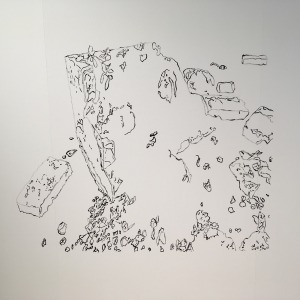Richard Canning graduated from the Belfast School of Art, Ulster University, in 2018 with a series of A1 size rectangles carrying line drawings.

The current exhibition still flirts with that mute agent of the change, accepting the artist’s intention to make large scale line drawings this time.

Drawing is a glorious chapter of humanity’s leaving marks. Not always to describe the ownership of a territory, Canning stresses the difference between in and out. Belonging and not.

Canning situates the drawn motif in an empty abstract space evoking simultaneous being and nothingness in the world, in the perception, in any intention.
( 1943: Jean-Paul Sartre:https://en.wikipedia.org/wiki/Being_and_Nothingness)
To become one, both the full and empty present themselves with the conviction of the bird’s song, the song, and the pause… echoed in the title of this exhibition: The Space Between
Cut out of the whole, the detail below makes visible the sensibility of the drawn line, stretched or waved or pulsating, as well as its mimetic force, namely in the open door.
 Trace of transitory being
Trace of transitory being
The gallery handout introduces the thought of “intimacy” made visible through the empty spaces and unfinished lines. I sense an approximation of going down the stairs and through that open door. Its lower vertical edge is equidistant, on a midpoint, between two other points: the lowest loop of the left balustrade and the top end on the right one. With the rest of the wall (glass rectangles ?), it forges a right-angled triangle.
I perceive that as a kind of intimacy between the full and empty, between the mark and its ground. Canning photographed the Student Union building opposite the Queens University in Belfast in the process of abandonment and demolition.

One of the exhibits in The Space Between translates this view into a line drawing.

Comparing the photography and drawing exposes Cannings process.

In addition, the absences and presences in the drawing remove some haptic weight of the material. Instead, the drawn objects insist on forging something entirely different – visual discourse between what is visible.

The corner made by a row of many and the separate single invites thoughts on hierarchy and exclusion. The easy chair dominates and prevents the single chair to join the many, like a class barrier may do. The size of the single chair on the right is wrong in relation to its position. So are the last stacked chairs on the left of the easy chair. That perception animates the composition and nudges it to obtain the symbolic meaning of inequality and division of power among people. I can almost “hear” the inflated ego of a person who might have sat in it. This interpretation is validated by the switch in the scale of the identical chairs, the same design, and manufacture, yet, some are different, smaller.
Canning’s visual intelligence manages to be fresh and measured at the same time. A good value. He invents representational minimalism rooted in the prestige of technical drawing, of architectural drawings, but slipping away from the expected “correctness”.

Actually, the drawing dances away from the correctness in another exhibit. Reminiscent of the freedom of the medieval marginalia, the drawings prefer the subtlety of privacy in visual art – so rarely presented on this scale.

The viewer is offered a mute proposition inspired by compositional rules, angles, distances, lines, scale, which Canning made visible. It is a loftier part of the imagination that these drawings activate.
Italo Calvino distinguishes between two types of imagination: the one that starts with a word and ends in an image, the other starts at the image and ends in words. (Six Memos…:83) Canning started with a word and a photograph (“Upon hearing of the imminent demise… as stated in the gallery handout paragraph 3) and ended with a drawing not afraid of absences.
Images courtesy Paula LARKIN.